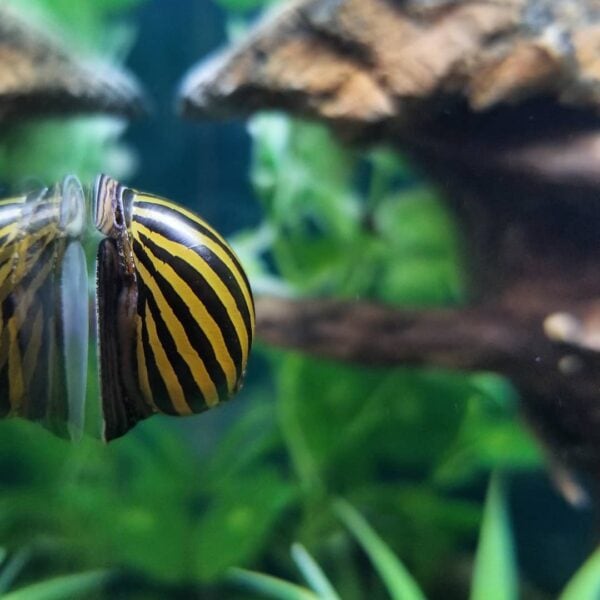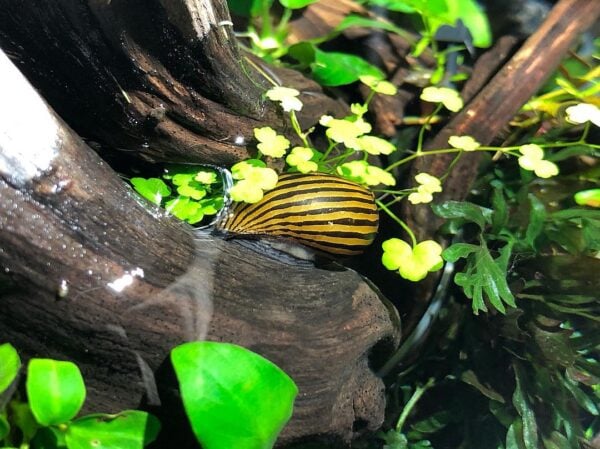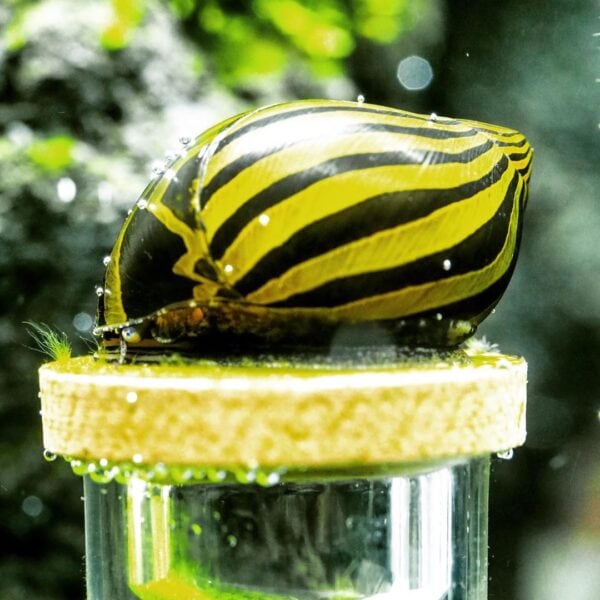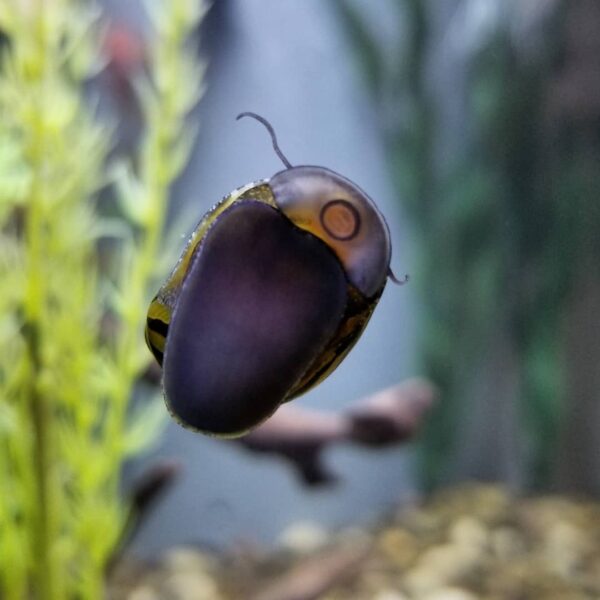
Interested in having a beautiful, black and gold striped snail with an unquenchable appetite for algae? What a superb choice!
But even if you’ve got nothing to do with them, stick in and you’ll surely want to have one in your tank.
The zebra nerite snail is a peaceful creature, and because of its extreme liking towards algae, it can be considered your personal tank cleaner. They can clean algae off your tank’s glass, decorations, tank plants and so forth.

In this article, I’ll be guiding you through zebra nerite snails’ characteristics and how to care for your own! Let’s dive straight in!
| General Characteristics | Details |
| Caring Difficulty | Easy |
| Lifespan | 2 Years |
| Size | 1’’ |
| Color | Black and Gold Stripes |
| Family | Neritidae |
| Environment | Saltwater/Freshwater |
| Tank Capacity | 5 gallons per Snail |
Table of Contents
Overview
The zebra nerite snail is one of the most popular species of the neritidae family of sea snails. They’re native to East Africa’s coastal plain, particularly, Mozambique, Kenya, Somalia, South Africa, and Tanzania.
Zebra nerites are extremely popular for their attractive shape, as well as their practicality. They aren’t a hassle to take care of, they’re extremely adaptable and robust. Also, they do keep your tank clear and clean off pesky algae.
These algae-loving snails are herbivores, where they feed on plants and greens in general.
However, one thing that makes zebra nerites special is that it exclusively feeds on green algae and not plants, this means that you can still put plants in your aquarium. They’ll remain intact.
Besides, they aren’t hermaphrodites (animals that have reproductive organs of both sexes), opposite to their land snail counterparts.
They’re peaceful, they’ve got nothing to do with hunting. However, they’re easily preyed upon by big fish who deem these snails a nice appetizer. Take care of who your snail’s neighbors are!
A Look Into The Lifestyle of A Zebra Nerite
They’re solitary creatures in which they don’t bother anyone. Even if you’ve purchased a group of zebra nerites, you’d always find each individual snail sitting alone.
They don’t really care about having company, so you can purchase only one snail and, rest assured, it won’t feel lonely and miserable.

They can stay awake for 30+ hours, and sleep intermittently. Over a period of 13 to 15 hours, they can have 7 short bouts of sleep.
They just go on their algae cleaning duties, which is done slowly but perfectly. They won’t leave a speck of algae behind.
On their journey to cleanliness, your snail may seem like it has flipped upside down. They usually can flip back, but if you’ve noticed that it’s been a while hurry up and flip it back! Your snail may die if it remains flipped upside down for a prolonged period of time.
What do zebra Nerite snails eat?
The green algae which makes your tank look hideous are like gourmet food for a zebra nerite. Not only green algae but technically most types of algae such as soft algae, hair algae, brown algae, and black beard algae is also on the menu.
Even if a Zebra Nerite is starving, it won’t come near your tank’s plants, which a bonus point.
If your tank doesn’t contain THAT much algae, you may need to provide supplementary food for your snail(s).
How can I tell if my tank has enough algae? Well, if your tank doesn’t need scraping due to algae formation every month or so then it probably doesn’t have sufficient algae. You’d have to supplement with one of these alternatives:
- Blanched vegetables as zucchini, carrots, kale, spinach, and lettuce
- Algae wafers
It’s worth to note that Zebra Nerites may take some time to adapt to supplementary food, but they’ll live through it.
Do Nerite snails eat lettuce?
Yes, lettuce is a great supplement if your zebra nerite snail is not getting enough algae. Just lightly blanch it before feeding it to them.
What Are The Tank Conditions for a Zebra Nerite Snail?
Please note that if you stock too many snails, you’ll have to provide supplementary food as the natural accumulation of algae in the tank won’t be sufficient for all of them. The general rule of thumb would be 1 snail per 5 gallons.
Tank
You should absolutely make sure your tank is covered. Zebra nerites are amazing escape artists, they’ll keep crawling up the side of your tank. If your tank isn’t covered they’ll fall out of it.
Zebra nerites are tidal snails, meaning that they can stay out of water for a good amount of time without dying or anything. If they did fall out of your tank they’d live, but you can’t risk them falling on their backs and being unable to flip back. This may kill them.
Water
Zebra Nerites are perfectly fine with freshwater or saltwater. But keep in mind that they can only reproduce in saltwater.
Acidity
The water in your tank should be of a pH level ranging from 6.5 to 8.5.
Temperature
They’re fine with temperature ranging from 72 ~ 78 Fahrenheit.
Salinity
If your tank’s water is saltwater, salinity should be kept between 1.020 ~ 1.028 sg.
Hardness
Is water hard! Yes. Water hardness is simply a measure of Calcium and Magnesium levels in water. The more Ca and Mg, the harder the water is.
Zebra Nerites prefer harder water since their shells are mostly built off calcium compounds. Hence, they absorb calcium, which aids in their shells’ growth.
If your tank’s water isn’t as hard, you can add a limestone chip in your filter to harden water.
Ammonia, Nitrate, Nitrite, and Copper Compounds’ Levels
All these compounds are extremely toxic for Zebra Nerites. These should all be close to zero ppm.
If you fill your tank with tap water, be extra watchful of your water’s copper levels as tap water may contain high levels of it.
You won’t be needing fancy equipment to maintain these compounds’ levels. Just a proper heater and a filter will do the job.
Substrate
In case you don’t know, the substrate is what you fill the bottom of the tank with.
Now the best substrate for zebra nerites would be a fine-grained sand substrate. Why’s that? Well, your snail has very delicate tentacles that may get damaged from a rocky substrate.
There’s a type of sand substrate, calcium substrate, which is primarily composed of calcium, that would be ideal for your snails to ensure their proper calcium intake.

How Big Do Zebra Nerite Snails Get?
Initially, zebra nerites are sold ⅓~½’’ in diameter. However, provided with care, love, and lots of algae, zebra nerite snails may grow in diameter to reach a size of 1’’.
Breeding
Zebra nerite snails are either male or female. However, differentiating between both sexes is quite difficult.
Therefore, if you want to buy snails for breeding purposes, you’ll need to buy a group of snails so that chances are that there’s a male or a female included.
Female zebra nerites, just like fish, lay eggs for male zebra nerites to fertilize. Once fertilized, these eggs grow into larvae. A zebra nerite larvae can only survive in a saltwater medium.
However, breeding in captivity isn’t such a nice idea, it’s shown that snails bred in captivity have drastically shorter lifespans.
How long do zebra Nerite snails live?
The average lifespan for a zebra nerite snail is about 1 year, however the most hardy and healthy ones can live over 2 years in the right environment.
The Takeaway
Zebra nerite snails are nice little creatures who give free tank cleaning sessions. They aren’t troublemakers in the slightest and are easy to take care of given their proper conditions. They’re also affordable, in which they’re mostly sold for $4. I can’t fathom a reason why you wouldn’t have one in your tank, to be honest.
